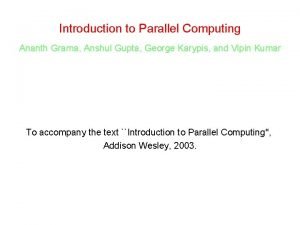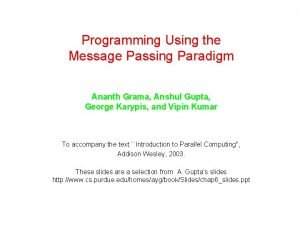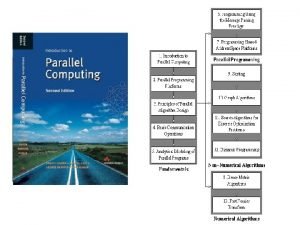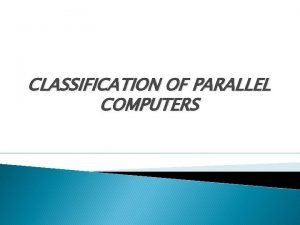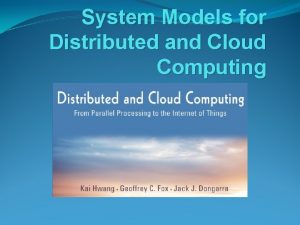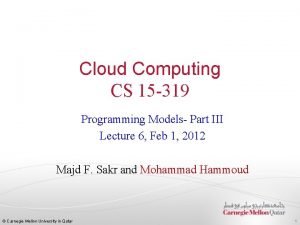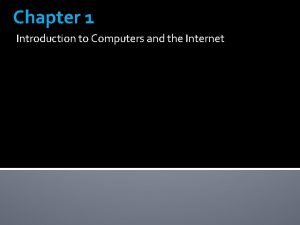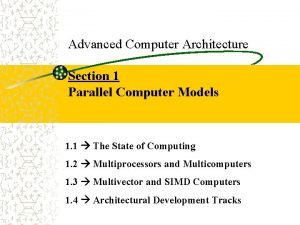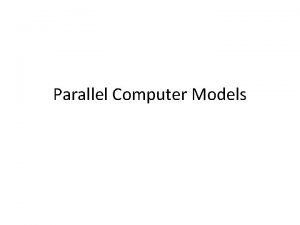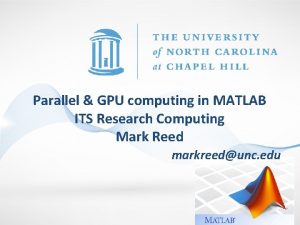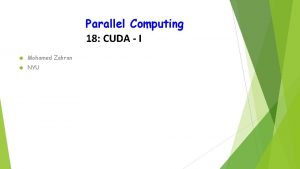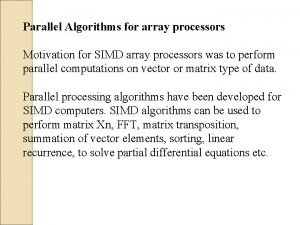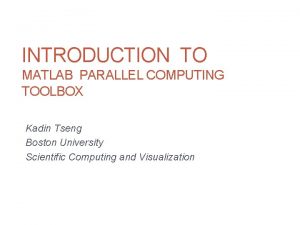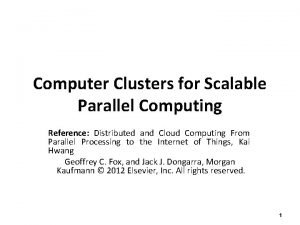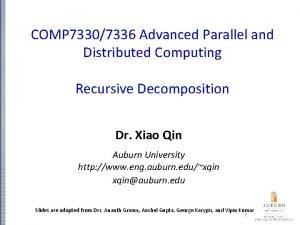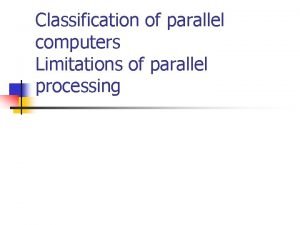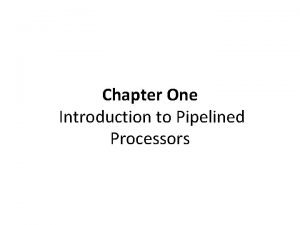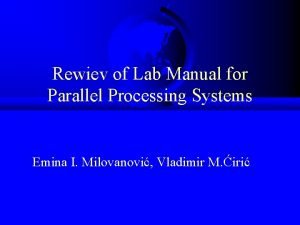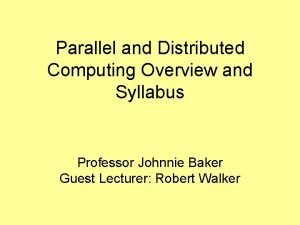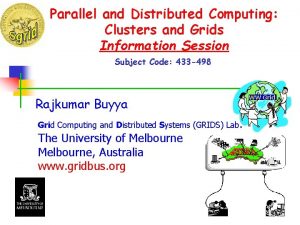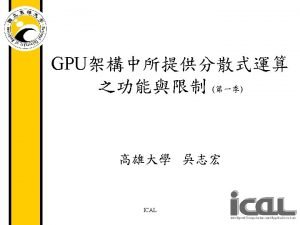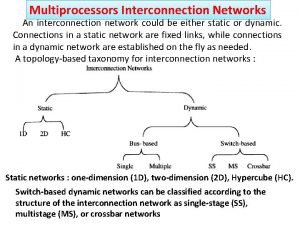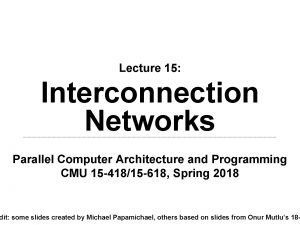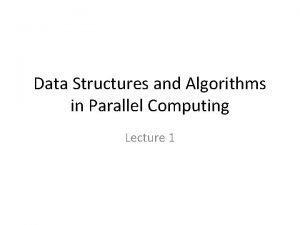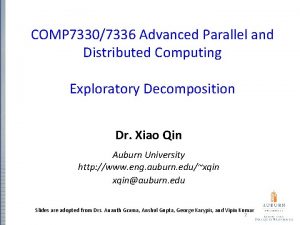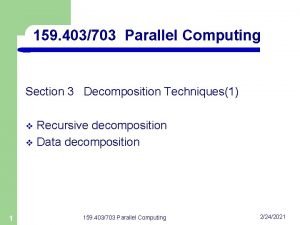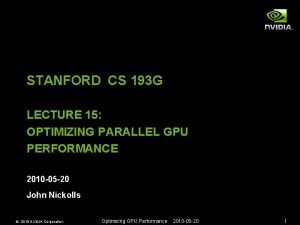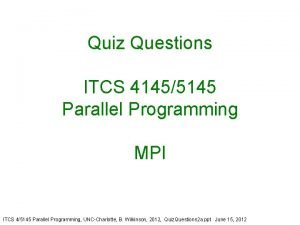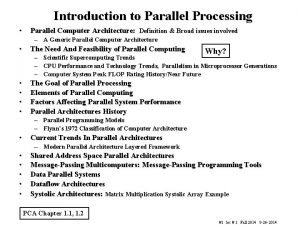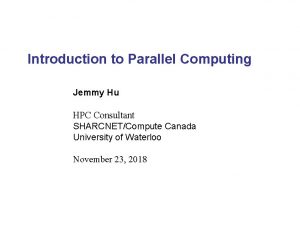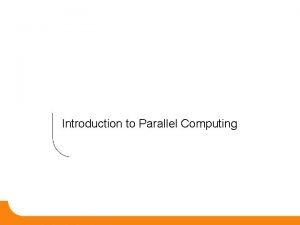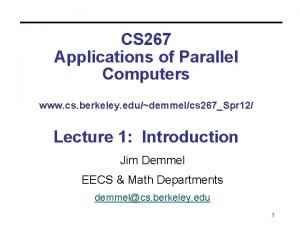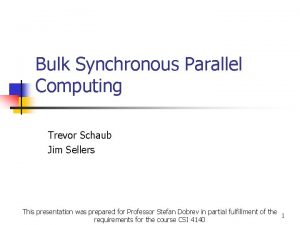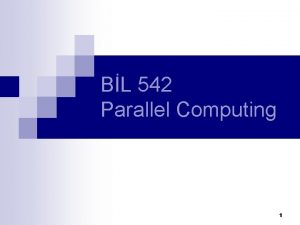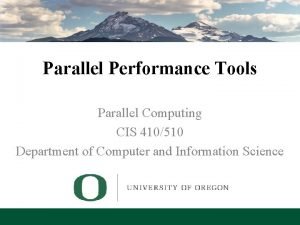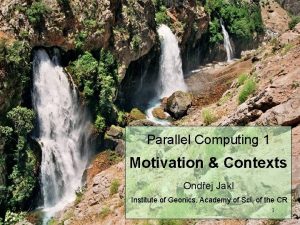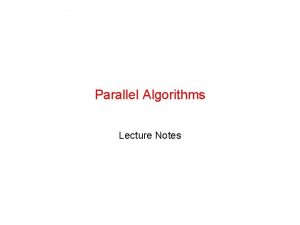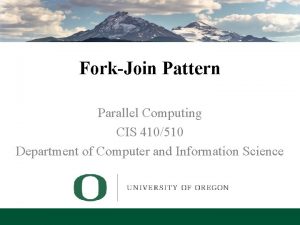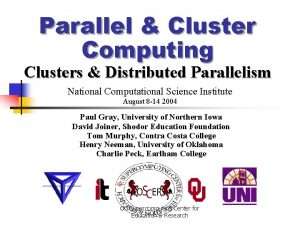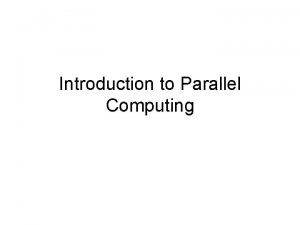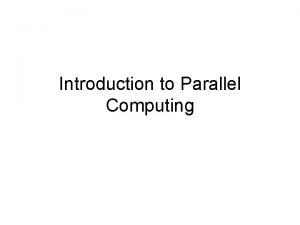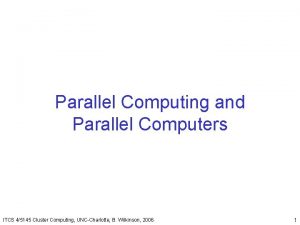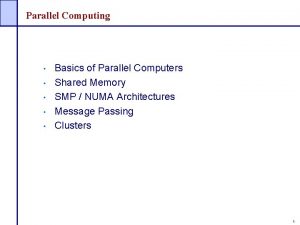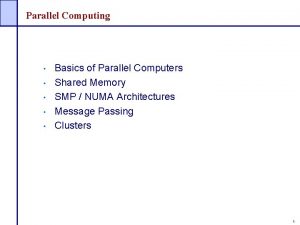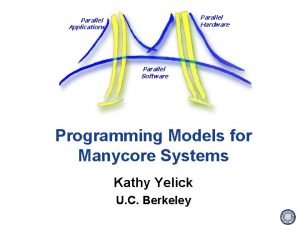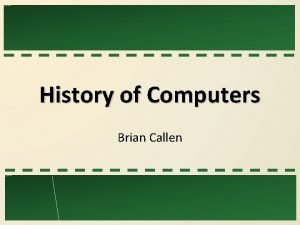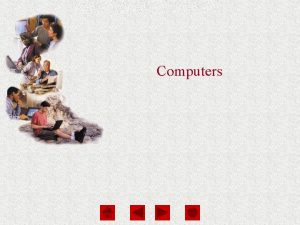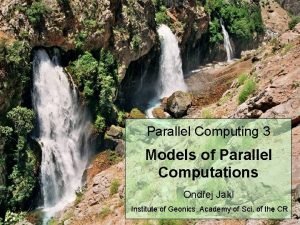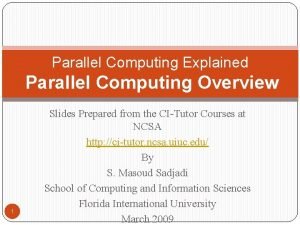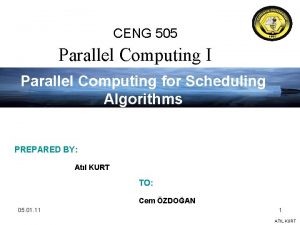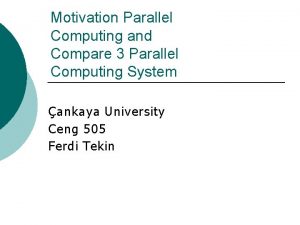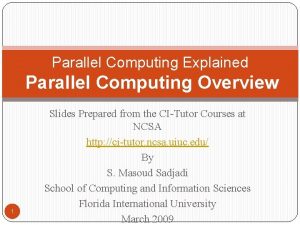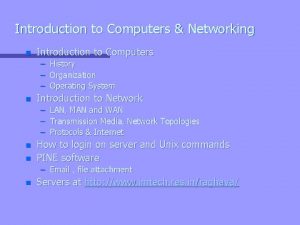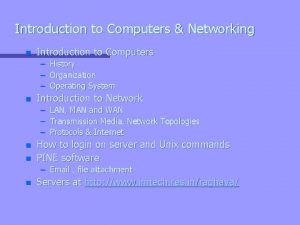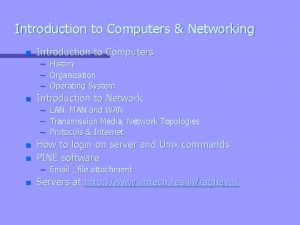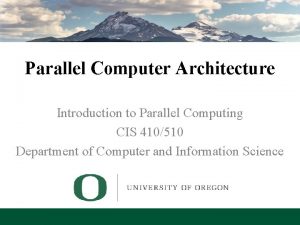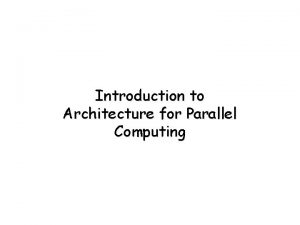Introduction to Parallel Computing Models of parallel computers


















































- Slides: 50

Introduction to Parallel Computing

Models of parallel computers: SEQUENTIAL 1. PE M M 2. PE M M

M 3. PE Code M M 4. With Pipelining : f 1 f 2 f 3 f 4 1 M 1 i -------------------------------------2 M 1 i 1 M 2 i -------------------------------------3 M 1 i 2 M 2 i 1 M 3 i

TAXONOMY • • Control Address Space Interconnect. Net. Granularity 1. Control: • SISD – Single Instruction Stream Single Data Stream. - Single program less memory. • SIMD – Single Instruction Stream Multiple Data Stream. - Dedicated hardware (expensive). • MISD – Multiple Instruction Stream Single Data Stream. - Rigid. • MIMD – Multiple Instruction Stream Multiple Data Stream. - program & data all PEs. - Own the self hardware (inexpensive). - flexible

SIMD MIMD global Control Local Control

Address – Space: - Two paradigms: - Message passing - Pain PE + Memory. - Shared Memory - Each PE accesses any location in memory. Message Passing: INN P 1/M P 2/M P/M

Shared Memory: M 1 P 2 P 3 I N N Global Memory Mn Easier to program need specialized hardware(expensive). To minimize communication: Hiding latency technique.

M P NUMA P M Local M m P Local M m I N N Global Memory P Local Memory M P M M I N N

Inter connection Networks: Static (direct) – for message passing Dynamic (indirect) – for shared memory - Fine grain- do not require frequent communication. PRAM- model- (idealized parallel computer. ) P- processor (shave common clock- each works on its own instruction) M- global memory uniformly accessible to all PEs. Synchronous shared- memory computers MIMD. Interaction between PE occurs at no cost.

How is memory accessed by R & W? • • EREW – weakest, minimum concurrency. CREW – write access serialized, read is concurrent. ERCW – write access is concurrent, multiple read access is serialized. CRCW – short powerful – can be simulated on a EREW model. CR – does not need modification in program. CW – access to memory requires arbitration. Protocols: Common – iff all values are identical. Arbitrary – an arbitrary PE proceeds other PEs fail. Priority – PE with highest priority written. Sum – sum of all quantities is written.

Dynamic Inter Connection Networks : i. e. EREW PRAM: – P- Processor m- words in global memory switching elements (Determine the memory word accessed. ) each P can access any of the memory words : -> # member of switching elements Ѳ(mp). (UMA) => expensive => performance Solution: Ø Reduce m try using memory banks (m words organized in b banks) Ø Each P switches between b banks Ø Total # of switching elements Ѳ(bp) Ø Less expensive Note: This is a weak approximate. Of EREW because no 2 PE can access the same memory bank at the same time.

Crossbars Switching Nets M 0 P 1 Pp-1 M 2 Mb-1

Bus-Based Networks Global M BUS UMA

Solution- provide local-cache -> reduces the total # of access to global memory - This implies replicating data => Cache coherency problems Global M BUS Cache

Multistage Interconnection Nets. High # of switching elements Bottle neck Þ Multi stage – provides best trade off. Þ Cost better than CROSS BAR Þ Perf. Better than BUS cost Cross bar Multistage BUS P Perf. Cross bar Multistage BUS P

Multistage Interconnect Net. 6 mega Network: P = # PE B = # memory banks P=b log P = # stages

Model of Parallel Computers

- Switch configuration in one Stage. Pass- through Cross - Over Given by the MSB corresponding to that stage.

Static Interconnection Nets. - Used in message - passing Completely - Connected Net

Star-Connected Net. - Central PE(bottle neck) - Similar to but - Communication 2 -steps. Linear Array and Ring Linear Array Ring

Tree Net - Only 1 path between any pair of PEs. - Linear arrays and star-connected nets. are special cases of tree nets Static – each node Corresponds to a PE Dynamic – only leaf nodes are Pes - Intermediate nodes are Switching elements S D

Fat Tree : increasing the number of communication links for PEs closer to the root => In this way bottlenecks at higher levels in the tree are alleviated. 0 -d 1 -d 2 -d 3 -d



100 000 010 101 001 100 110 Figure HC 2: Three distinct partition of three dimensional hypercube in twodimensional cubes. Link connecting processors within a partition are indicated y bold lines. 010 101 111 011 110 001 111 011 100 000 110 010 101 001 111 011

Fig: b) HC 3

Fig: b) HC 3

Properties:


Evaluating static Interconnection Nets (in terms of costs and performance) S d









(a) (b) Fig: A tree rooted at processor 011(=3) and embedded into a threedimensional hypercube: a) the organization of the tree rooted at processor 011, and b) the tree embedded into a three-dimensional hypercube.

Routing Mechanism for Static Networks Routing mechanism: determines the path a message takes through the network to get from the source to the destination processor. - Considers : - Source - Destination - Info about state of net - Returns one or more path(s) Classification (criteria): -congestion – minimal : (shortest path between source and destination) - does not take in consideration congestion - non minimal: (avoid network congestion)(path may not be shortest) - Use of state of network info – deterministic routing(does not use net. info) - Determines a unique path - Uses only source and destination info. - adaptive (uses network state info. Avoids congestion)

X Y

100 110 Ps 010 Pd 111 000 101 011


time

Cut- through routing store and forward routing: - communication time is high - poor utilization of communication resources Cut through routing: message is advanced from the incoming link to the outgoing link as it arrives - message travels in small units called flow control digits a flits (pipelined through the net) - an intermediate processor does not wait for the entire message to arrive before forwarding it. As soon as flit arrives, it is passed on to the next processor. - all flits are routed along the same path Note: - no need for buffer space to store entire message at intermediate PEs. - uses – less memory (storage) - less memory bandwidth - it is faster

t




 Introduction to parallel computing ananth grama ppt
Introduction to parallel computing ananth grama ppt Introduction to parallel computing ananth grama ppt
Introduction to parallel computing ananth grama ppt Introduction to parallel computing ananth grama
Introduction to parallel computing ananth grama Classification of parallel structure
Classification of parallel structure What is the difference between models and semi models
What is the difference between models and semi models All resources are tightly coupled in computing paradigm of
All resources are tightly coupled in computing paradigm of Cloud computing programming models
Cloud computing programming models Greg ganger
Greg ganger Conventional computing and intelligent computing
Conventional computing and intelligent computing Chapter 1 introduction to computers and programming
Chapter 1 introduction to computers and programming What is a computer?
What is a computer? Chapter 1 introduction to computers and programming
Chapter 1 introduction to computers and programming What is computer oriented society
What is computer oriented society Chapter 1 introduction to computers and programming
Chapter 1 introduction to computers and programming C programming chapter 1
C programming chapter 1 Parallel computer models
Parallel computer models 1 crore
1 crore And matlab
And matlab Mohamed zahran nyu
Mohamed zahran nyu Simd parallel algorithms
Simd parallel algorithms Drange matlab
Drange matlab Design objectives of computer clusters
Design objectives of computer clusters Recursive decomposition example
Recursive decomposition example Cloud computing lecture
Cloud computing lecture Limitations of parallel computing
Limitations of parallel computing Unifunction and multifunction pipeline
Unifunction and multifunction pipeline Parallel computing lab manual
Parallel computing lab manual Parallel and distributed computing course outline
Parallel and distributed computing course outline Cluster in parallel and distributed computing
Cluster in parallel and distributed computing Conclusion of parallel computing
Conclusion of parallel computing Static interconnection network
Static interconnection network Cmu parallel computing
Cmu parallel computing Data structures for parallel computing
Data structures for parallel computing Exploratory decomposition in parallel computing
Exploratory decomposition in parallel computing Communication operations
Communication operations Recursive decomposition in parallel computing
Recursive decomposition in parallel computing Cs193 stanford
Cs193 stanford Mpi questions and answers
Mpi questions and answers Parallel computing definition
Parallel computing definition Parallel computing
Parallel computing Parallel computing
Parallel computing Itanium architecture
Itanium architecture Cs 267
Cs 267 Superstepn
Superstepn Parallel computing
Parallel computing In parallel computing
In parallel computing Parallel computing
Parallel computing In parallel computing
In parallel computing Parallel distributed computing
Parallel distributed computing Fork join pattern
Fork join pattern Distributed, parallel, and cluster computing
Distributed, parallel, and cluster computing
